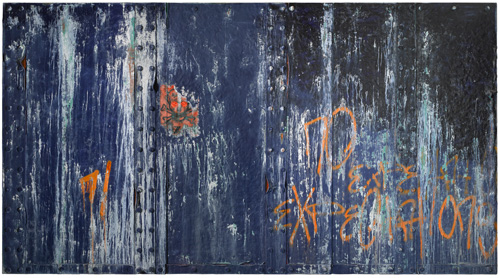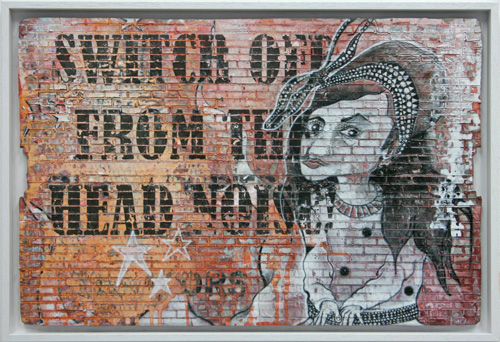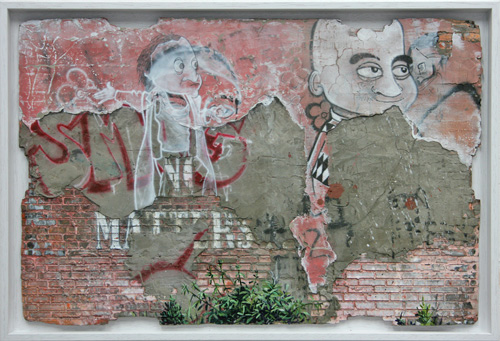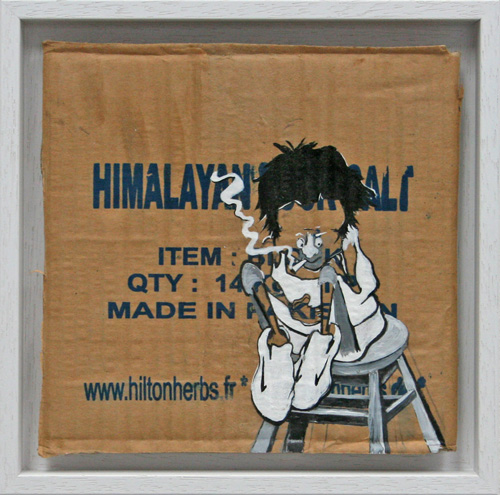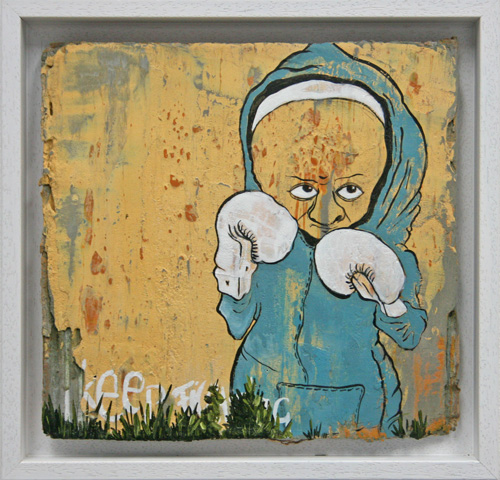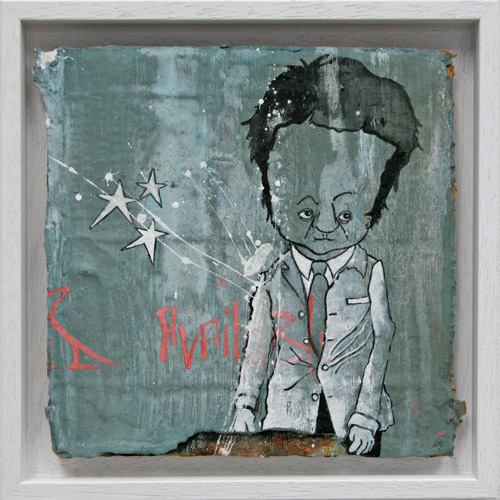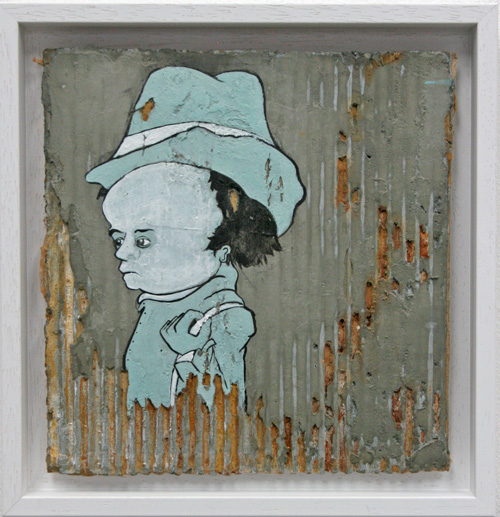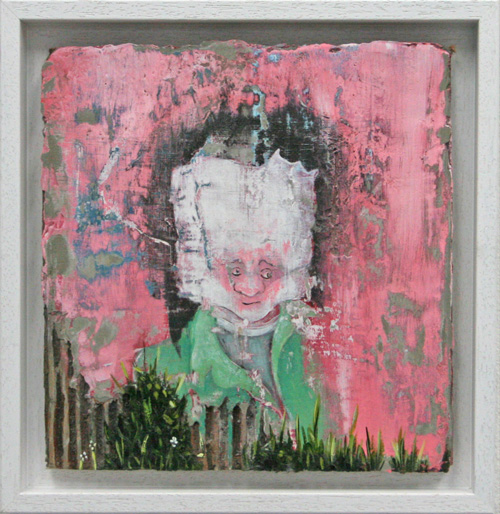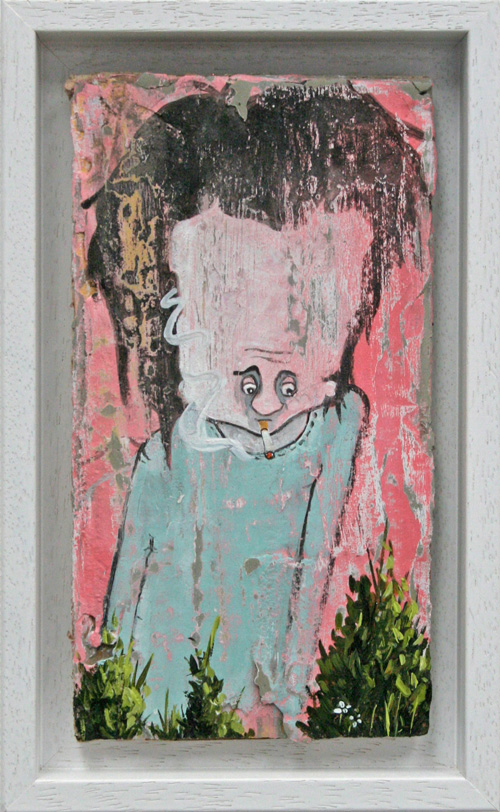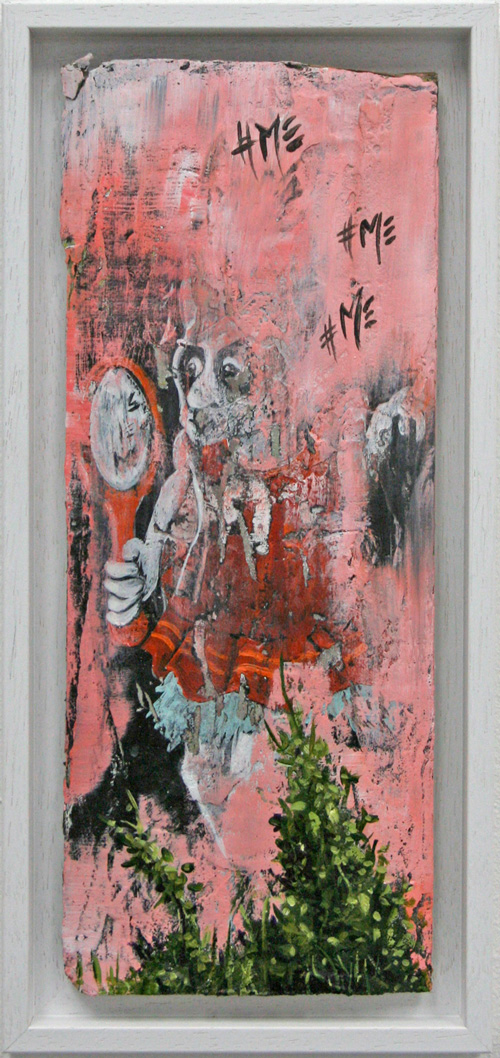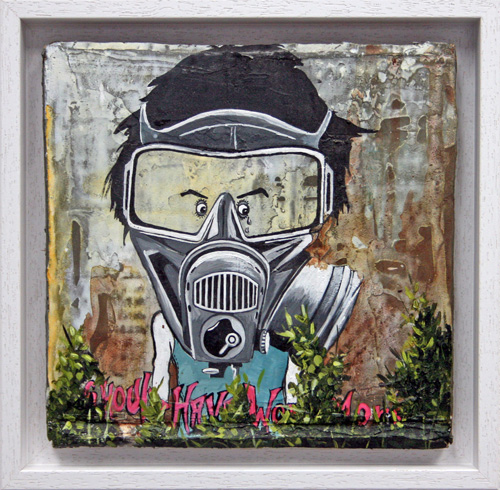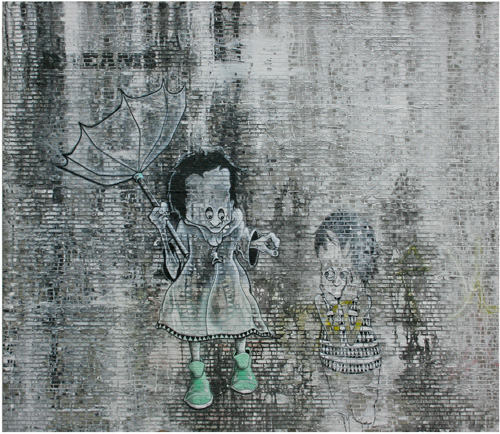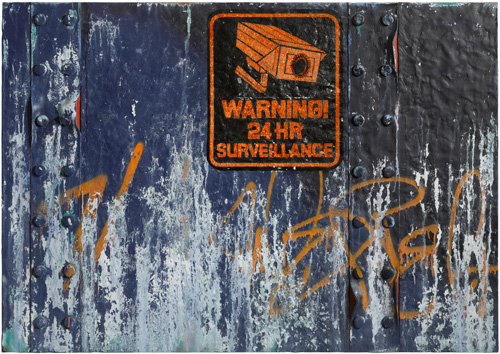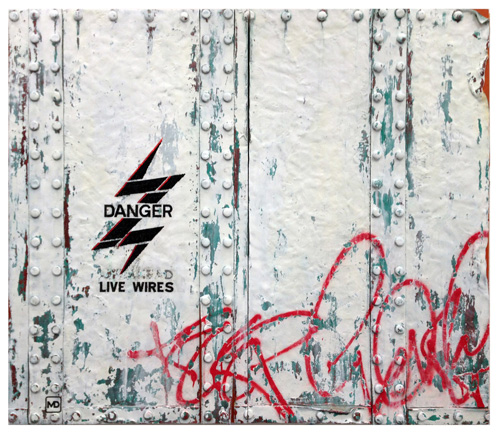

CNB Gallery, London
7 October – 12 November 2015
by ANNA McNAY
Deep beneath the ground in the heart of Shoreditch, a basement brims with hooded figures; pithy, stencilled statements; exposed bricks; graffiti tags and corrugated steel sheets. But these are not crude scribbles on a cellar wall; these are carefully crafted paintings – worth a bob or two, at that – by Miranda Donovan, a City and Guilds-trained artist, who refers to her deeply layered and textured works as “sculptural paintings” and who, through her own self-exploration, questions and challenges the viewer’s concept of the human condition.
The venue is the CNB Gallery – formerly Cock and Bull – named after the infamous Damien Hirst tank containing a Hereford cow and a cockerel, preserved in formaldehyde, and elevated above diners in the centre of the former electricity generating station, now Mark Hix’s Tramshed restaurant, directly above. Donovan and Hix first collaborated in 2009, when the artist was commissioned to create a bespoke mobile for his Soho restaurant. They have continued to work together on and off ever since.
The works on show in the subterranean gallery are taken from three series. The largest pieces, which look for all the world like immense (2 x 3.7 metre) steel sheets, studded with rivets, are, in fact, made out of resin. The buckling and rusting combines to form a contemporary trompe l’oeil. The amount of energy required to warp and tarnish these sheets is scarcely imaginable, and at odds with Donovan’s seemingly fragile frame. This contradiction is further reflected in the sparkling Swarovski crystals set into the sheets. On No Expectations (2013-14), they form a skull and crossbones – perhaps a reference to Hirst and his diamond-encrusted skull, For the Love of God (2007). The glittering, bling gems certainly offer a comment on the chasm between wealth and poverty and the extremes of society, asking, perhaps: Which is uglier? Why do some artists make millions while others struggle to survive? The juxtaposition of the delicate and intricate with the scribble and scrawl echoing the mismatch and seeming paradox of the high value of street art.
The skull is a recurring motif in Donovan’s work and visitors are greeted by a painted motherboard (See, Hear and Speak No Evil, 2014) with three skeletons mimicking the three wise monkeys of Japanese tradition. In the dark, the elements glow. There is a comfy chair in front of the work, where visitors might sit and “relax”, although the idea is that they will experience the incessant humming and buzzing of the computer, perhaps recognising it as an ingredient of their everyday life. Again, Donovan seems to be making a comment, this time on the inescapability of today’s 24/7 lifestyle and perhaps, beyond this, on the passive-aggressive influence of television and video games.
Around the corner hangs a work in which an Amy Winehouse-esque figure appears alongside the words: “Switch off from the head noise!” A poignant plea, with the title Flick the Switch (2015), referring to the simple option that so few of us are able to take when it comes to gadgets and devices with an on/off switch – but also, more ominously, to the temptation to flick that ultimate switch and escape from it all for good.
This work, and the others from the same series, showcase another of Donovan’s fantastic surface techniques of creating a canvas of tiny bricks – so real you could believe they were cut ready and laid in rows – crumbling at the edges with erosion and overgrown by hyperreal vegetation. In Fractured (2015), part of the main surface has flaked off, just like an old wall, revealing a palimpsest of previous imagery, pencil marks and spray paint, scratching out and scratching into – the wall as everyman’s canvas: readily available, temporary and vast. Hanging against a real brick wall, the effect is magnified.
Fifteen smaller works, displayed almost like pieces from a jigsaw waiting to be slotted together, are taken from the 2014 series Diary of My Other Self, showing androgynous figures variously frowning, smoking, wielding a machete or gun, singing, boxing and wearing a gas mask. Who is this other self and does Donovan wish to let him/her out? He/she doesn’t seem like someone I’d particularly want to meet, but then we all have aspects of ourselves best kept under wraps, and to create these raw and physical works, some degree of anger or vigorous emotion must necessarily be involved.
Another repeated motif across the paintings is that of a young girl standing with her umbrella blown inside out. One example, a monotone, rain-splashed, age-worn work entitled Nothing to Fear (2015), has the word “DREAMS” stencilled just above the umbrella. It is unclear, however, whether these dreams are escaping from, or being caught by, the upturned umbrella. Certainly the girl looks vulnerable, exposed to the harshness of society, but, at the same time, she has someone leading her on, telling her, one might suppose, not to fear. Whether this girl is Donovan and the guide her other self, or whether it’s the other way around, who knows? Maybe Donovan wouldn’t even be able to say. The point is that the works express a certain dichotomy, a vulnerability inherent in modern-day life, for which a tough, street-kid veneer is often a necessary defence. As the title of the show itself suggests: these unsettling, almost Gothic horror-like figures, are metaphors for mankind.
